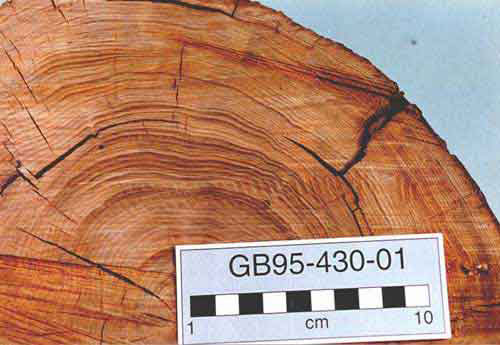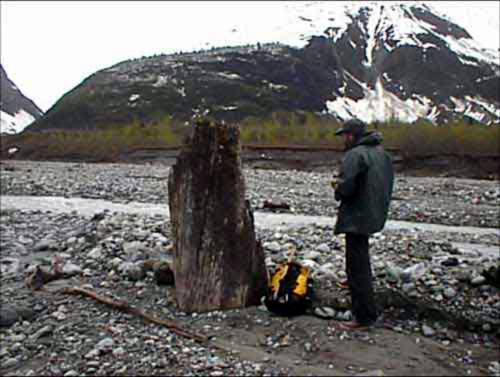 Glacier, bay, glacier, bay,
glacier, Glacier Bay
Glacier, bay, glacier, bay,
glacier, Glacier Bay
By Ned Rozell
March 11, 2006
Saturday
During the last 11,000 years, Glacier Bay has been filled with
ice and has lost its ice at least three times, according to scientists
who sample the remnants of ancient forests first identified by
naturalist John Muir in Glacier Bay National Park.
Daniel Lawson and David Finnegan
have collected hundreds of samples from trees that grew within
the bay between advances of the ice. Both men work at the Cold
Regions Research and Engineering Lab in Hanover, New Hampshire.
 A cross-section from
an ancient stump in Glacier Bay National Park.
A cross-section from
an ancient stump in Glacier Bay National Park.
Photo courtesy David Finnegan.
In 1989, Lawson started traveling to Glacier Bay in the summer,
averaging about three trips each year. Finnegan joined the research
group several years later. To get to their study sites, they
drive a boat to the many inlets in the bay, go ashore, and hike
up the newly exposed valleys in search of tree stumps. Some gray
stumps are standing in positions they've held for thousands of
years; advancing glaciers buried the bases of the trees with
sediments, preserving them. Lawson and Finnegan core some trees
and extract slices from others that show tree-ring patterns and
then bring the wood back to their lab in New Hampshire. Lawson
says the fieldwork is fun, and hard to beat when the weather
is nice.
After documenting the location
of the stumps with GPS receivers and collecting the samples,
they radiocarbon date each sample to find out when the tree lived,
which also tells them when an inlet was free of ice. Early results
on Reid Inlet, where Reid Glacier has now backed up out of the
ocean, show that the glacier had retreated beyond where it is
now more than 10,000 years ago, advanced to the sea by 8,000
years ago, again retreated beyond where it is now about 7,000
years ago, and the ice once again advanced to Reid Inlet beginning
about 5,000 years ago. Other glaciers in the bay have followed
the same here-and-gone pattern over the last 1,000 or more years.
 An ancient tree stump,
still standing in place in Glacer Bay.
An ancient tree stump,
still standing in place in Glacer Bay.
Photo courtesy David Finnegan.
Why would Glacier Bay fill up and empty so many times in a relatively
short amount of time? Lawson, Finnegan, and Richard Alley of
Penn State University think fluctuations of the sun may be responsible.
The sun has more punch during some times than others, and those
periods of intensified solar activity might coincide with the
beginning of ice retreats within Glacier Bay. Glaciers in the
bay may have grown when the sun was weaker, such as it was during
the Little Ice Age about A.D.1300. Lawson and Finnegan's early
results seem to support the sun/glacier connection, but they
have much more work to do to confirm their
idea.
Glacier Bay is one of the world's
great examples of fast ice loss - Captain George Vancouver reported
a wall of ice at the entrance to the bay as he sailed by in the
late 1700s, and a mass of ice one mile high and more than 50
miles long has disappeared since. Might advancing ice someday
block cruise ships from one of Alaska's most popular tourist
attractions?
"If we get significantly
reduced solar activity, then potentially, yeah. The bay could
fill with ice again," Lawson said. But solar fluctuations
can take a long time from a human perspective; don't plan on
skiing the great Glacier Bay icefield anytime soon. Water skiing
is the more likely option.
"Will the ice come back
in our lifetimes? Probably not," Finnegan said.
This column is provided
as a public service by the Geophysical Institute, University
of Alaska Fairbanks, in cooperation with the UAF research community.
Ned Rozell is a science writer at the institute.
Publish A Letter on SitNews Read Letters/Opinions
Contact the Editor
SitNews
Stories In The News
Ketchikan, Alaska
|


